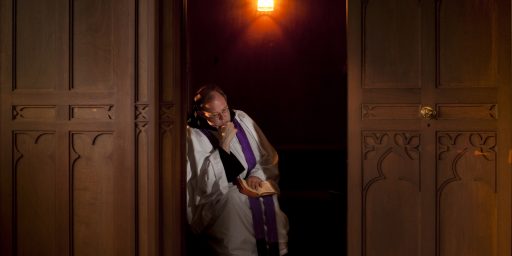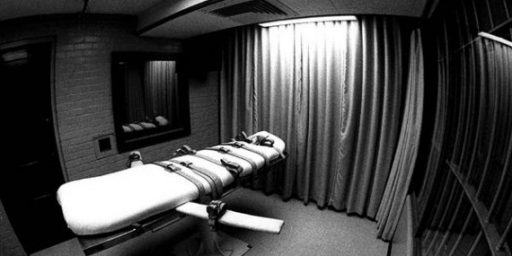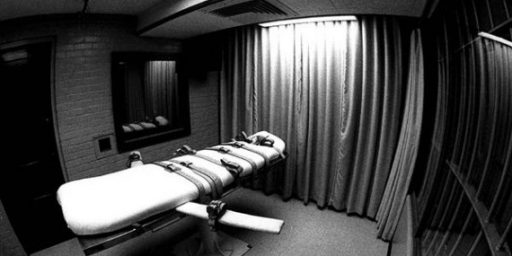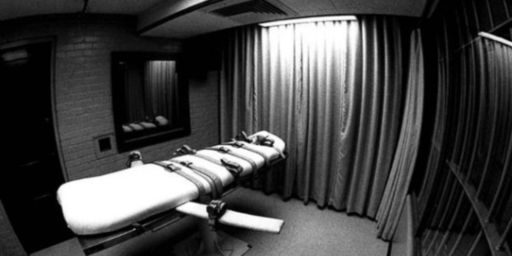New York Man Released After 23 Years In Jail For Crime He Didn’t Commit
David Ranta spent 23 years in jail because of lying witnesses and corrupt police.
David Ranta was released from jail yesterday in New York City twenty-three years after being convicted of a murder he never committed:
David Ranta walked out of State Supreme Court in Brooklyn on Thursday a free man, after spending more than two decades in a maximum-security prison for a crime he almost certainly did not commit.
Mr. Ranta, who was convicted in 1991 of one of New York City’s most notorious murders, only to spend years fighting to prove his innocence, was escorted by guards into a courtroom. His hands were bound in handcuffs, linked by a chain to a brown leather belt around his waist.
Justice Miriam Cyrulnik listened to brief statements from the defense lawyer, Pierre Sussman, and from the office of Charles J. Hynes, the Brooklyn district attorney. Then she fixed her eyes on Mr. Ranta, a man of modest stature, his hair thin and graying, his mouth playing with an uncertain smile.
“To say that I’m sorry for what you have endured will be an understatement and grossly inadequate, but I say it to you anyway,” she said to him softly, her eyes red-rimmed. “Sir, you are a free man.”
With that, more than a dozen relatives and friends in the benches behind him broke into applause and sobs. Mr. Ranta turned to them, as guards unshackled him.
The details behind Mr.Ranta’s conviction raise serious questions about the criminal justice system:
In the wintry darkness 23 years ago on a back street in Williamsburg, Brooklyn, a jewelry thief fleeing a botched robbery panicked and shot a Hasidic rabbi in the head.
Four days later, the rabbi, Chaskel Werzberger, an Auschwitz survivor, died of his wounds. Even in the New York City of 1990, as homicides crested at 2,245, the murder stirred grief and outrage. The “Slain Rabbi” was front-page tabloid news. Mayor David N. Dinkins traveled to Williamsburg’s Satmar enclave to sit in mourning and to offer a $10,000 reward.
The new Brooklyn district attorney, Charles J. Hynes, stood shoulder to shoulder with fur-hat-wearing Satmars, watching as they rocked back and forth and wailed as the pinewood coffin was carried out. He vowed to bring the killer to justice.
Forty detectives worked the case, soon led by the swaggering, cigar-chewing Detective Louis Scarcella. Working closely with an influential Satmar rabbi, Detective Scarcella arrested a drug-addicted, unemployed printer named David Ranta. Hasidic Jews surrounded the car that carried the accused man to jail, slapping the roof and chanting, “Death penalty!”
Mr. Ranta was convicted in May 1991 and sentenced to 37.5 years in maximum-security prison, where he remains to this day.
He is almost certainly not guilty.
(…)
In the decades since a jury convicted him of murder, nearly every piece of evidence in this case has fallen away. A key witness told The New York Times that a detective instructed him to select Mr. Ranta in the lineup. A convicted rapist told the district attorney that he falsely implicated Mr. Ranta in hopes of cutting a deal for himself. A woman has signed an affidavit saying she too lied about Mr. Ranta’s involvement.
Detective Scarcella and his partner, Stephen Chmil, according to investigators and legal documents, broke rule after rule. They kept few written records, coached a witness and took Mr. Ranta’s confession under what a judge described as highly dubious circumstances. They allowed two dangerous criminals, an investigator said, to leave jail, smoke crack cocaine and visit with prostitutes in exchange for incriminating Mr. Ranta.
At trial, prosecutors acknowledged the detectives had misbehaved but depicted them as likable scamps. Reached in retirement on Tuesday, Mr. Scarcella defended his work. “I never framed anyone in my life,” he said.
No physical evidence ever connected Mr. Ranta to the murder.
Reading further about the case, it seems utterly clear that Ranta was framed for this murder from the very beginning. It’s not mentioned in the report excerpted above, but the lineup witness that was told to lie by police was a thirteen year old boy at the time, obviously someone heavily subject to coercion by the police. Moreover, it appears that all of the evidence against Ranta that was presented at trial was some form of eyewitness testimony. As I’ve noted before, eyewitness testimony is far less reliable than lay people seem to think that it is, and it becomes even less reliable when it’s combined with people who are actually lying, either on the suggestion of the police or otherwise, it becomes even less reliable. The final element of Ranta’s conviction was his supposed confession to the lead detective in the case, but as we all know such confessions are not nearly as reliable as believed, and become even more so when combined with witnesses who lie and police who, under pressure to solve a high profile case, deliberately falsify evidence. Most importantly, Ranta’s confession was not documented in any way. There was no audio or video recording, as has become customary in recent decades and was being used in New York City at the time Ranta was arrested, and Ranta was not asked to sign a written transcript of any confession. The only evidence of Ranta’s confession was the testimony of the Detective who claims he made it. Ranta has consistently denied for twenty three years that he made no such confession. Finally, it’s worth noting just how many other inconsistencies there were during the course of Ranta’s trial:
Powell and Otterman report that “four of the five witnesses in the first lineup did not identify Mr. Ranta.” Furthermore, the eyewitness who should have gotten the clearest look at Werzberger’s killer, the diamond courier he tried to rob, testified at the trial that Ranta was “100 percent not” the right man. The jury evidently gave more weight to other witnesses, including one who was 13 at the time and now says a detective told him to pick Ranta out of a lineup.
It’s worth noting that at the time Ranta was convicted New York State still had the death penalty. It was not repealed, via judicial decision, until 2004. Evidently, he was not charged with First Degree Murder, but it’s certainly possible that he could have been. While New York never actually executed anyone during the years after the death penalty was reintroduced in the state during the Pataki Administration, it’s entirely possible that Ranta could have spent the last 23 years on Death Row. It’s cases like this, then, that I oppose the death penalty. There’s simply too much room for error and corruption to ever be sure of the result.






It’s a shame he can’t take everything Scarcella and Chmil have. It’s a shame they won’t be sent to jail for 23 years. They put an innocent man in jail and stole 23 years of his life. It’s disgusting that they’ll probably get away with it.
It seems like there is a steady drumbeat of these stories. And that’s exactly why I’m anti-DP.
For a while, I was optimistic that modern forensics would end this sort of thing. And modern forensics has been useful in freeing some innocent prisoners. But I’ve also seen articles like this where the screwup/corruption was at the lab. And people are likely to take forensic analysis as semi-gospel…
I hope he sues each individual in their personal capacity and the state and cleans up. Nothing can comepensate him for what he went through but each of those individuals involved need to feel some of his pain.
I distinctly remember this case. Truly a local cause celebre. Especially given the context of the Dinkins years, which were an unmitigated disaster for the city, rivaling even the pre-Koch fiasco of the 70’s.
Obviously a colossal miscarriage of justice. One of the worst ever, one can presume. And of course given the demographics of Internet blogs the high dudgeon mode reactions will be as thick as knives.
Here’s a thought or two, not in terms of solutions, in the literal sense of that term, because what’s done is done and corruption can’t be prevented in advance, but in terms of non-emoting responses and non-loopy approaches towards trying to reduce the risks of a repeat performance.
We need more public interest defense, appeal and writ criminal attorneys. Especially in capital and other homicide cases. Especially if we’re talking about qualified such attorneys. The harsh reality is that the ones we have at present tend to be the bottom of the barrel. Sad but true. Granted, from time to time a major law firm will handle cases like this pro bono, but that’s a rare event. Occasionally a law professor or two will chime in, but they’re not real practicioners.
So the question then arises about spending and tax priorities. Every dollar spent studying salamanders, subsidizing operas and underwriting philosophy degrees, for example, is one less dollar the government can spend on public interest attorneys. The same holds true for every dollar spent paying the bills of the able-bodied. This is something over which the left can’t get past its cognitive dissonance. The outrage over a case like this is there. Rightfully so. But it’s in the follow up that the left utterly fails.
We should spend more public money trying to prevent these sort of miscarriages of justice and less public money handing out largesse for various pointless and self-defeating endeavors. Period. The “war on poverty?” A quagmire if there ever was one. How about a war on police and prosecutor corruption? It’s about common sense and common cents, too. Righteous indignation merely to be righteously indignant doesn’t in the real world actually accomplish anything. Utilitarian responses are what’s necessary. Less emotion. More logic. Less talking. More doing.
@Rob in CT: Forensics will always suffer from this problem. And there’s no way around it because not every murderer is a TV killer who leaves a handy trail of direct evidence behind. The biggest problem for forensic analysis is that only specialists really understand the science that gets thrown around in courtrooms. People with limited or tangential expertise are often pulled in to present cases to the court, where either they want to sell their science as perfect and unquestionable (cf arson “expert” Manuel Vasquez, who played a part in dooming Cameron Todd Willingham) or they are forced to dumb down science to a lay audience that expects something perfect and unquestionable. Prosecutors know this and kick people off juries if they’re too educated. It really is shocking to hear how often horribly incomplete or simply discredited “science” enters testimony — almost as shocking as how often jailhouse snitches are used to seal convictions.
@ptfe:
And that get’s to the most dangerous point about the “promise of science” to tell the truth or eliminate bias. All too often too much faith is put in the “idea of science” rather than looking at its practice.
This isn’t to say that forensic science should be discounted — and I know you are not suggesting that. Science is still the best process out there for coming to understand many aspects of the world around us.
But to treat it as infallible or a panacea to the ills of our legal system would be a mistake.
@Rob in CT:
The problem is that most “forensic science” isn’t actually science. Crime labs could easily be set up so that all tests are performed with a double blind set up (e.g. Here’s two sets of 10 bullets; do any of the bullets in the first set match any of the bullets in the second set?) but are purposely set up so that the technicians know the “right” answer in advance (e.g. Did this bullet, taken from crime scene X, come from this gun, taken from home of suspect Y?)
Their purpose is not to investigate the truth, but to justify a pre-ordained conclusion.
Just to be clear, my comments above should not be taken as suggesting that science *cannot* be trusted or that, for example, mainstream scientific thought on an issue like Climate Change is riddled with bias. An important thing to remember, especially with experimental science, is that findings are constantly questioned and tested by the existing scientific community. And that leads to the build up of evidence.
This is different than what happens in forensic science. The underlying processes have all been subject to a high degree of scrutiny to ensure that they are reliable. The individual results of each forensic process, on the other hand, don’t face that same level of scrutiny.
Please channel more of this Tsar: We need more public interest defense, appeal and writ criminal attorneys.
Yes. And legal aid. America has vast wealth. We can afford all of this, and operas, higher education, and more.
@matt bernius:
Some of these techniques have been, but for others there is no universal standard as to what is what. Unfortunately, as @Stormy Dragon: said, much of forensic science isn’t science at all. Another problem with it is that labs are funded by police departments, they know which side their bread is buttered on.
@OzarkHillbilly:
Let me add that I doubt there is very much out and out lying done by technicians (it does happen), but in cases where the outcome is unclear they can be pressured to “lean” one way or the other.
Lou Scarcella needs to be arrested and indicted for his role in perpetrating this conspiracy against Ranta. What he did went far beyond “breaking rule after rule” — these were outright criminal acts to pervert the course of justice, including coercion and witness tampering. The Brooklyn DA has the facts — now it needs to use them. Scarcella should not spend another day as a free man.
@rudderpedals: That was close!
Tsar almost had me, until he started picking on cheap liberal/education/science budget priorities (salamanders? really?) instead of F35-type boondoggles when re-allocating scarce federal budget dollars toward things that are actually useful, or even wanted, by the military.
I wish I cared enough to do the math to figure out how many salamander studies we could do for the cost of just one F35 – much less the entire program.
Just to elaborate more on my example. Even if a particular technique is valid (e.g. determining whether two bullets were fired from the same gun), an improper experimental set up can still lead to invalid results. Suppose we want to know if suspect gun Y fired bullets collected at crime scene X. Good design would be:
Tech gets 10 bullets (A-1 through A-10): 2 from crime scen X, 2 from suspect gun Y, and six more fired from three random guns of the same calliber). They also get 10 bullets (B-1 through B-10): 2 more from crime scene X, 2 from suspect gun Y, six from three random guns, one or two of which (randomly selected without techs knowledge) was also used for producing the A bullets.
Tech returns a report indicating which bullets in A are matches with bullets in B (and there can be multiple matches on each side, e.g. A-2 could match both B-3 and B-7).
The tech now knows there should be some bullets that match, some that don’t match, and has no idea in advance which are supposed to be which or even how many of each there are supposed to be.
Now we have data to statistically test the hypothesis (the bullets from crime scene X and the bullets fired by suspect gun Y are all fired from the same gun) both in terms of confidence, as well as significance. We also have an audit trail that can be track how accurate the technique is, both in general and in terms of this particular tech.
@Rob in CT: Were you living in Connecticut during the Kenneth Ireland trial? http://www.innocenceproject.org/Content/Kenneth_Ireland.php
I always find it remarkable that the same far-right nuts who scream loudly about the incompetence of the government to do anything suddenly turn around and claim they have absolutely no doubt about its ability in finding the right person as defendant in criminal cases. Particularly death penalty cases.
I’d be in favour of the death penalty were it not for the remarkable number of cases where the prosecutor or witness has lied, fudged the facts; the judge has been bribed, the jury has convicted on a dingbat “scientific theory” or similar. Hence, no, no death penalty, please. Not until the court system can get its error bars to be much smaller
@grumpy realist:
That’s one I’ve never been unable to understand either.
@george: Trials tend to involve juries. Juries, comprised of fellow citizens, do no equate with “the government”. It’s not the prosecutor who determines the verdict, but the panel of jurors. The penalty phase may or may not be handled by the jury, depending on state law. You’ll find plenty of conservatives (and liberals) who have issues with judge-decided verdicts.
@John Burgess:
Correct. However the government, in the form of the prosecutor and the police, present the case and the government, in the form of the judge oversees the case.
And in cases of evidence suppression and overzealous prosecution, the two sides have a lot of power to, knowingly or unintentionally, heavily weight on their side of the scale.
For that reason alone, the death penalty should be eliminated as an option.
Ranta has suffered a heart attack and has been hospitalized for testing. I hope he survives to enjoy his freedom.
@matt bernius:
That sums it up nicely. In almost any endeavor, if one group has control over what evidence is presented, then they have control of the outcome.
And I’ll add, the government is even in control in who gets pulled in for jury selection (ie the defendant can’t go out and select people outside of the ones the government has chosen as the candidates). If you don’t trust the government, capital punishment should be a non-starter for this fact alone.
@grumpy realist:
Doesn’t the reverse of the logic apply. Progressives who want the government to run health care, transportation, education, and manage the economy, always claim that the police are incompetent, stupid, lazy, and should never be trusted.
If you listened to many progressives, it is amazing that there is any crime committed in the U.S. given that everyone is innocent and is being framed. Short of getting the crime on video, there is no way to make a progressive happy when it comes to convicting criminals.
@george:
Kinda… Remember that both sides can strike jurors. But once one get’s beyond the automatic strikes, the government takes control as the judge has the final say on a given strike.
@matt bernius:
But the defense can only strike candidate jurors who’ve been selected by the government in the first place. That’s fine if you trust the government, but should set off warning bells among people who don’t.